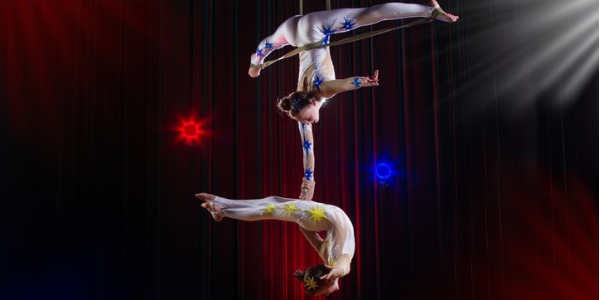What is an Acrobat?
An acrobat is a performer who uses their body to do amazing physical feats, often involving balance, strength, flexibility, and coordination. Acrobatics can include tumbling, flips, handstands, juggling, balancing on tightropes, or performing on trapezes. Acrobats practice for years to develop the skills needed to move safely and gracefully while performing these challenging stunts. Their goal is to entertain audiences with impressive and exciting displays of physical ability.
Acrobats can perform in many settings, such as circuses, theaters, street performances, or dance shows. Some acrobats perform alone, while others work in groups, creating complex routines that involve lifts, throws, and coordinated movements. In addition to skill and practice, acrobats must also focus on safety, using mats, harnesses, or spotters when learning new tricks. Acrobatics combines athleticism, artistry, and creativity to create performances that are both thrilling and visually captivating.
What does an Acrobat do?

Duties and Responsibilities
Here are some common duties and responsibilities of an acrobat:
- Skill Development and Training: Acrobats spend a lot of time practicing to improve strength, flexibility, balance, coordination, and overall fitness needed for their performances.
- Choreography and Routine Development: Acrobats design and perform routines that show their skills and artistry. They plan movements, transitions, and sometimes work with directors or other performers to create synchronized routines.
- Performance Preparation: Acrobats prepare before shows with warm-ups, stretching, and mental focus. They may also participate in rehearsals to refine their routines.
- Performance Execution: The main responsibility of an acrobat is to perform dynamic routines, including flips, jumps, balances, and other stunts, while maintaining control, timing, and precision.
- Safety Awareness and Risk Management: Acrobats focus on safety by checking equipment, using spotting techniques, and following proper landing methods to avoid injury.
- Collaboration and Teamwork: Acrobats often work with other performers, choreographers, and directors. They communicate and coordinate to ensure smooth and synchronized performances.
- Maintenance and Equipment Care: Acrobats take care of their equipment, such as mats, bars, hoops, and rigging. They inspect, maintain, and report any issues to keep everything safe and in working order.
Types of Acrobats
There are various types of acrobats, each specializing in different disciplines and techniques. Here are some common types of acrobats and a brief description of what they do:
- Aerial Acrobats: Perform routines while suspended in the air using apparatuses such as silks, hoops, trapezes, or ropes. They demonstrate strength, flexibility, and grace through aerial maneuvers, drops, spins, and contortions.
- Floor Acrobats: Perform routines on the ground without aerial equipment. They showcase agility, balance, and tumbling skills through flips, handstands, cartwheels, contortion poses, and partner or group acrobatics.
- Contortionists: Highly flexible acrobats who bend, twist, and stretch their bodies into seemingly impossible positions, displaying strength, flexibility, and fluidity.
- Hand Balancers: Focus on balancing maneuvers using primarily their hands. They execute handstands, one-arm balances, and intricate routines that require upper body strength and control.
- Acrobatic Gymnasts: Perform in pairs or groups, combining acrobatic skills with gymnastics elements. They execute partner balances, group lifts, synchronized tumbling, and complex routines requiring strength, flexibility, coordination, and trust.
- Trampoline Artists: Perform acrobatics on trampolines, including jumps, flips, twists, and somersaults. They demonstrate exceptional air awareness, timing, and body control.
What is the workplace of an Acrobat like?
An acrobat’s workplace can vary depending on the type of performance they do. Many acrobats perform in circuses or theaters, where the stage or performance area is equipped with mats, trapezes, ropes, or other apparatuses. These spaces are often large and open, allowing acrobats to move freely and safely while performing flips, jumps, and balancing acts. The environment is usually lively, with lights, music, and cheering audiences adding to the excitement.
Some acrobats perform outdoors at festivals, parades, or street events. In these settings, the workplace changes frequently and may include parks, streets, or temporary stages. Acrobats must adapt their routines to different spaces and surfaces while still entertaining the audience safely. These venues require flexibility, quick thinking, and creativity to make performances engaging in less controlled environments.
Acrobats also spend significant time preparing outside of actual performances. Their workplace can include practice areas, gyms, or rehearsal studios where they warm up, stretch, and refine their routines. Equipment like mats, trampolines, or balancing apparatuses must be carefully maintained, and acrobats often collaborate with trainers or fellow performers to ensure safety and synchronization. Even though the work can be physically demanding, it combines training, preparation, and live performance to create captivating shows.
Frequently Asked Questions
Circus-Related Careers
Performing-Related Careers and Degrees
Careers
- Acrobat
- Actor
- Aerialist
- Athlete
- Cabaret Performer
- Character Actor
- Circus Performer
- Clown
- Comedian
- Commercial Actor
- Conductor
- Contortionist
- Dancer
- DJ
- Drag Performer
- Film Actor
- Fire Breather
- Improv Actor
- Influencer
- Juggler
- Magician
- Method Actor
- Model
- Motivational Speaker
- Music Artist
- Musician
- Performer
- Session Musician
- Singer
- Stage Actor
- Stage Manager
- Stilt Walker
- Stuntman
- Talk Show Host
- Theatrical Director
- Tightrope Walker
- Trapeze Artist
- Ventriloquist
- Voice Actor
Degrees
- Acting
- Cinema Studies
- Fine Arts
- Music
- Music Theory and Composition
- Songwriting
- Theatre Arts
- Visual and Performing Arts